Spanish-Inspired Chickpea Paella
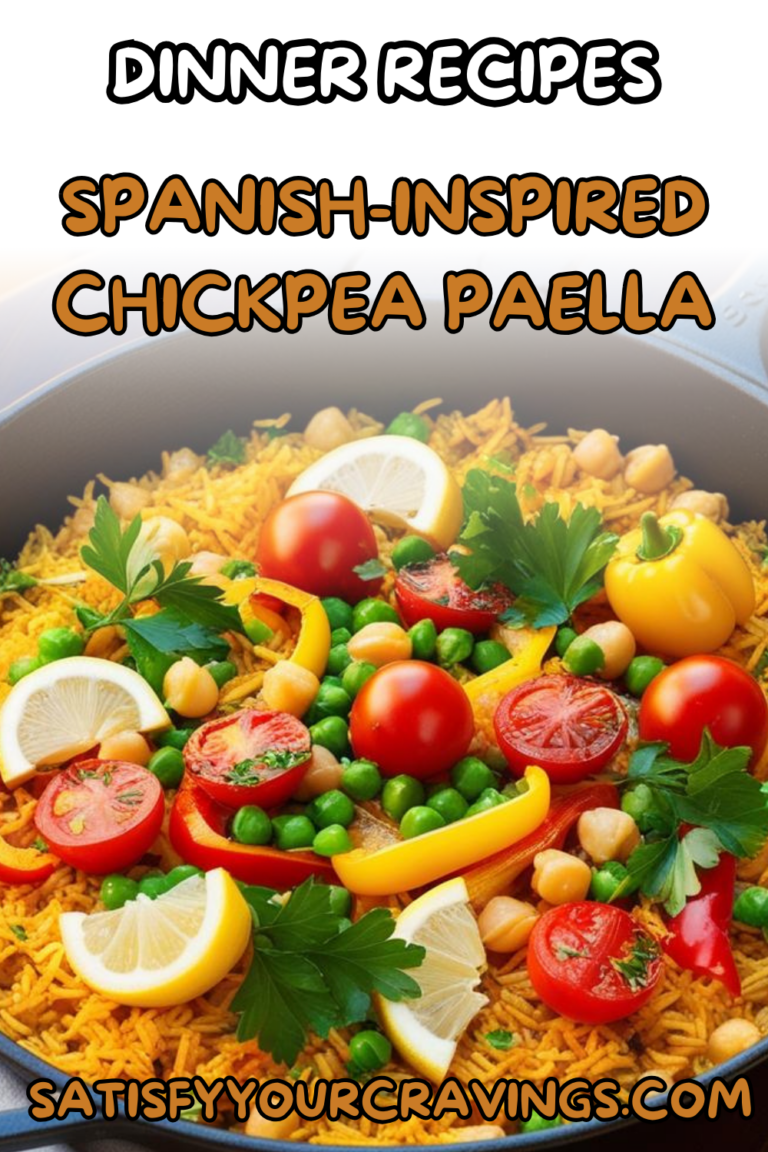
🌿 A Plant-Based Twist on a Spanish Classic You’ll Crave Again and Again
If you’re craving something hearty, flavorful, and totally nourishing, this Spanish-Inspired Chickpea Paella is about to become your new favorite one-pot wonder 🥘✨ Inspired by the vibrant coastal flavors of Spain, this plant-based version keeps things clean and wholesome without sacrificing the deep, smoky, saffron-kissed goodness that makes paella so magical. It’s the kind of dish that feels both comforting and celebratory — perfect for weeknight dinners, weekend gatherings, or anytime you want to treat yourself to something special (without spending hours in the kitchen!).
What makes this recipe extra crave-worthy? It’s loaded with protein-rich chickpeas, colorful veggies, and anti-inflammatory spices like turmeric and paprika, all simmered to perfection in a single pan. Naturally vegan and gluten-free, it’s a crowd-pleasing meal that’s great for meal prep, incredibly adaptable, and shockingly easy to make. Whether you’re already a paella lover or trying it for the first time, this clean-eating twist is sure to satisfy your cravings — and keep you coming back for seconds 💛🌱
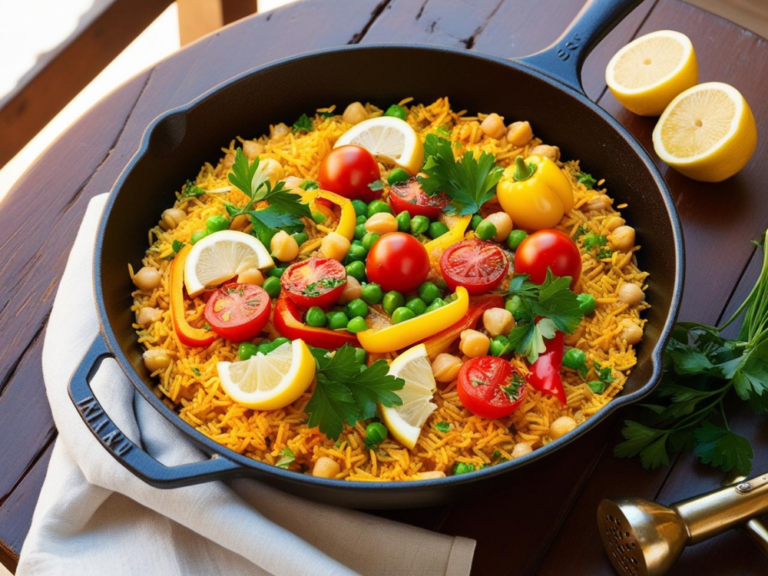
What Is Paella? A Spanish Classic with a Global Twist
If you’ve ever heard the word paella and wondered what all the buzz is about — you’re not alone! Paella (pronounced pah-eh-yah) is a world-famous Spanish dish that originated in the Valencia region of Spain, and it has since become a beloved staple across cultures, kitchens, and continents 🌍✨
At its core, paella is a rice-based dish cooked in a wide, shallow pan, often layered with flavorful ingredients like vegetables, saffron, and proteins. Traditional Valencian paella typically features chicken, rabbit, and green beans, but over time, paella has evolved into many delicious versions — from seafood-rich coastal styles to plant-based, veggie-forward adaptations like this Spanish-Inspired Chickpea Paella!
🍚 The Heart of Paella: The Rice
One thing all authentic paellas have in common is their short-grain rice base — usually bomba, calasparra, or arborio rice. These varieties are perfect for absorbing flavor without becoming mushy. The rice soaks up rich broth, spices, and aromatics, becoming tender and deeply flavorful while forming the prized socarrat — the slightly crispy, golden crust that forms on the bottom of the pan 😍
✨ Fun fact: Socarrat is considered the best part of paella in Spanish cooking — that golden, toasted layer of rice is a sign of a well-made dish!
🌿 The Signature Flavor: Saffron
The signature golden hue and floral aroma of paella comes from saffron, one of the world’s most prized spices. Just a small pinch brings warmth, color, and that iconic flavor profile that sets paella apart from other rice dishes.
🥘 More Than Just a Meal — It’s a Celebration
In Spain, paella isn’t just food — it’s a social event. It’s the kind of meal people gather around, cook slowly, and savor together on weekends and holidays. Traditionally, it’s cooked outdoors over an open flame, and served family-style straight from the pan. It’s rustic, flavorful, and meant to be shared ❤️
🧡 Paella, Reimagined for Clean Eating
This Spanish-Inspired Chickpea Paella keeps all the soulful, comforting elements of traditional paella — the spiced rice, the rich tomato base, the vibrant veggies — but gives it a plant-powered twist perfect for today’s clean-eating lifestyle.
No need for seafood or sausage — this version is 100% vegan and gluten-free, yet still deeply satisfying and packed with nutrients. Whether you’re new to paella or already a fan, this healthy spin is a celebration of flavor, culture, and nourishment on every level 🌱
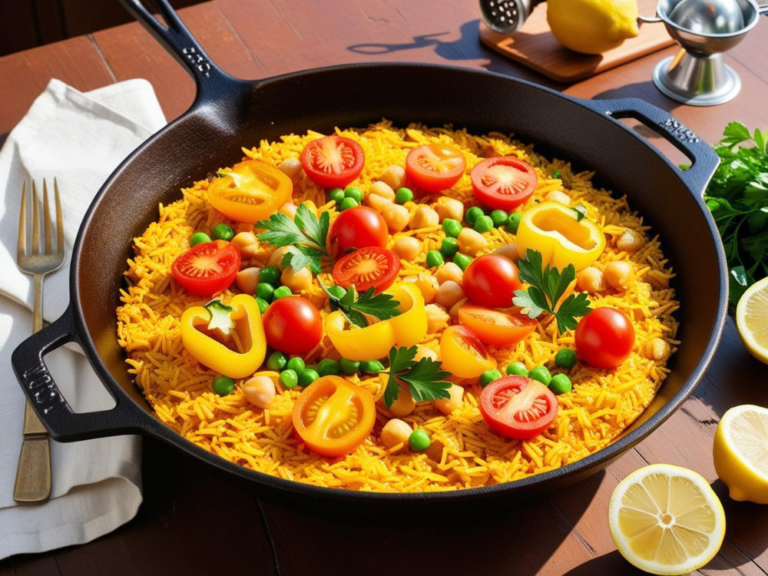
🥦 Nutritional Benefits of Spanish-Inspired Chickpea Paella
This Spanish-Inspired Chickpea Paella isn’t just a feast for your taste buds — it’s also a nutritional powerhouse packed with ingredients that nourish your body from the inside out 🌿 Let’s take a deeper look at the health-boosting goodness inside every flavorful bite:
🌱 Chickpeas – Plant-Based Protein & Fiber
Chickpeas are the star of this paella, and for good reason. These humble legumes are rich in plant-based protein (perfect for vegans and vegetarians) and loaded with dietary fiber, which supports digestive health, stabilizes blood sugar levels, and helps keep you feeling full longer. They’re also a great source of iron, magnesium, folate, and zinc, which are essential for energy, immunity, and brain function.
🍚 Arborio or Short-Grain Rice – Slow-Releasing Energy
This recipe uses arborio or short-grain rice, which provides a steady source of complex carbohydrates to fuel your body throughout the day. Unlike processed white rice, short-grain varieties offer slow-digesting starch, making them great for maintaining stable energy and supporting blood sugar balance.
🌟 Clean eating tip: Want even more fiber? Try swapping with short-grain brown rice!
🫑 Bell Peppers – Vitamin C Superstars
Colorful bell peppers aren’t just pretty — they’re packed with vitamin C, which supports immune function, collagen production, and iron absorption (especially helpful when eating a plant-based diet). They also provide antioxidants like beta-carotene and lutein, which protect your cells and promote glowing skin ✨
🍅 Tomatoes – Antioxidant Powerhouse
Tomatoes contain lycopene, a powerful antioxidant that’s been linked to reduced inflammation and heart health. Cooking tomatoes (like in this recipe!) actually makes the lycopene more bioavailable, which means your body can absorb it more efficiently 🙌
🧄 Garlic & Onions – Gut & Heart Health
This dynamic flavor duo is rich in allicin and prebiotics, which support gut health, help regulate cholesterol, and provide anti-inflammatory properties. They also help boost the immune system and act as natural detoxifiers for the body.
🌾 Saffron – Mood & Metabolism Support
Saffron might be small in quantity, but it’s big in benefits. This golden spice has been studied for its role in reducing anxiety, supporting digestion, and even balancing hormones. It’s rich in antioxidants like crocin and safranal, which protect the brain and reduce oxidative stress. Plus, its exotic aroma instantly elevates the dish and your mood 💛
🫛 Peas – Plant-Based Protein & Eye Health
Green peas provide extra protein, fiber, and a dose of vitamin A, K, and B vitamins. They’re particularly good for eye health and bone strength, and their natural sweetness adds a delicious pop to the dish.
🍋 Lemon Juice – Alkalizing & Detoxifying
A splash of lemon at the end isn’t just for flavor — it adds a bright dose of vitamin C, supports liver detoxification, and helps the body stay more alkaline. Plus, lemon helps enhance iron absorption from plant-based sources like chickpeas and peas.
✨ Put It All Together
This dish checks every clean-eating box:
High in fiber
Loaded with antioxidants
Rich in vitamins & minerals
Balanced with protein, carbs, and healthy fats
Anti-inflammatory & immune-boosting
You can feel amazing about serving this to your family, packing it for lunch, or enjoying it as part of your weekly clean eating rotation. Food that’s both comforting and healing? Yes, please! 🥰
Try some of our other recipes!
🌱 Why Plant-Based Paella Is Trending (And Why You’ll Love It!)
There’s a reason you’re seeing plant-based paella pop up on restaurant menus, Pinterest boards, and foodie Instagram feeds everywhere — it’s having a major moment in the world of healthy eating and sustainable cooking 
Let’s dive into the delicious reasons this meatless version of Spain’s iconic dish is taking the world by storm…
1.  The Rise of Plant-Based Living
The Rise of Plant-Based Living
Plant-based diets are more than a trend — they’re a lifestyle shift. Whether you’re fully vegan, vegetarian, flexitarian, or simply trying to eat more plants, the demand for meatless, nutrient-rich meals is skyrocketing. Plant-based paella fits perfectly into this shift, offering bold flavor, satisfying texture, and tons of versatility — all without the meat.
According to recent studies, nearly 1 in 4 Americans are actively reducing their meat consumption — and dishes like this make it deliciously easy.
2.  Comfort Food Without Compromise
Comfort Food Without Compromise
Let’s face it: we all crave comfort food. But who says comfort has to come with a heavy feeling afterward? Traditional paella is rich and hearty, but the plant-based version delivers all the cozy satisfaction without the heaviness. By swapping meat and seafood for chickpeas, veggies, and spices, you still get a warm, indulgent meal that leaves you feeling energized and nourished.
3.  Nutritional Benefits That Go Beyond the Plate
Nutritional Benefits That Go Beyond the Plate
Plant-based paella is loaded with fiber, plant protein, vitamins, and antioxidants, thanks to ingredients like chickpeas, bell peppers, tomatoes, and peas. Unlike traditional paella, which can be high in cholesterol and sodium, this version supports heart health, gut health, and stable energy — making it a smart choice for clean eaters and wellness warriors alike
4.  Sustainable & Eco-Friendly
Sustainable & Eco-Friendly
Choosing plant-based meals is one of the most impactful things you can do for the planet. Traditional paella often includes seafood or meat, which come with a higher environmental footprint. In contrast, chickpeas, rice, and veggies require fewer resources to produce, making plant-based paella a more sustainable and eco-conscious choice — without compromising on flavor.
Eat well, feel good, and do your part for the planet — all in one dish.
5.  Incredibly Adaptable for Every Diet
Incredibly Adaptable for Every Diet
One of the best things about plant-based paella is how easy it is to customize. Whether you’re gluten-free, dairy-free, soy-free, or oil-free, you can tweak the ingredients to suit your needs. It’s also perfect for batch cooking, meal prep, and feeding a crowd, since it’s budget-friendly, filling, and allergy-friendly.
6.  Family-Friendly & Kid-Approved
Family-Friendly & Kid-Approved
Many parents are looking for ways to get their kids to eat more veggies — and this dish makes it easy! The colorful ingredients, gentle spices, and fun one-pan style make it a kid-friendly dinner winner. Serve it in bowls with fun toppings like lemon wedges, olives, or avocado slices, and let your little ones build their own paella bowl!
7.  Instagrammable & Impressive
Instagrammable & Impressive
Let’s be real — this dish is gorgeous 
8.  A Cultural Classic with a Modern Twist
A Cultural Classic with a Modern Twist
People are craving authentic food with a healthy upgrade. Plant-based paella takes the beloved tradition of Spanish cooking and gives it a fresh, modern twist that’s aligned with today’s health-conscious lifestyle. It honors the roots of the original dish while making it more accessible and inclusive for today’s diverse eaters.
 It’s More Than a Trend — It’s a Movement
It’s More Than a Trend — It’s a Movement
Plant-based paella isn’t just trending — it’s transforming how we think about comfort food, sustainability, and nutrition. Whether you’re looking to eat cleaner, reduce your environmental impact, or just enjoy an incredibly tasty meal, this vibrant one-pot wonder is a perfect fit. Once you try it, it’s sure to become a staple in your weekly meal rotation.
So grab your skillet, pour that veggie broth, and let the saffron-scented magic begin!
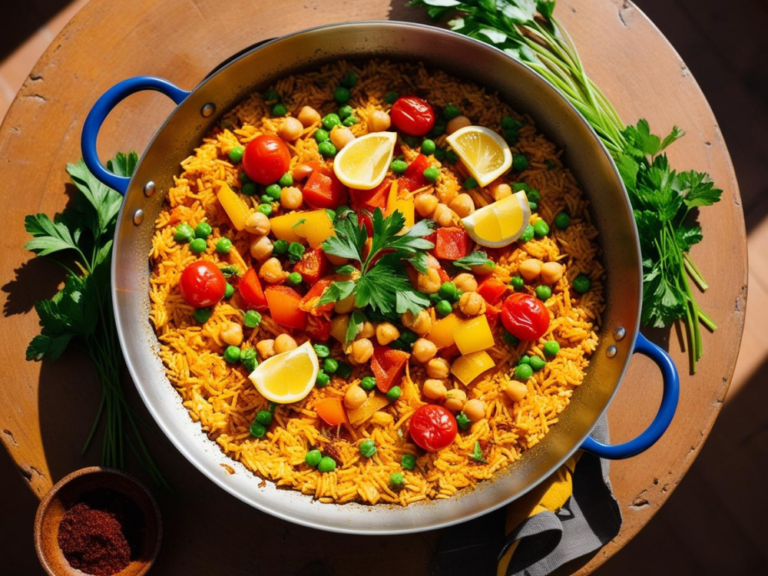
🌼 The Golden Duo: Health Benefits of Saffron + Turmeric
One of the things that makes this Spanish-Inspired Chickpea Paella so special — aside from the chickpeas and vibrant veggies — is the gorgeous golden hue and aromatic depth brought by saffron and turmeric 
Let’s take a closer look at this golden duo and why they’re so much more than just pretty spices:
 Saffron: The “Sunshine Spice” with Uplifting Properties
Saffron: The “Sunshine Spice” with Uplifting Properties
Often called the world’s most expensive spice (thanks to the delicate hand-harvesting process of its tiny red threads), saffron has been used for thousands of years in Mediterranean, Middle Eastern, and Ayurvedic cooking and medicine. A little goes a long way — and the benefits are impressive:
 Mood Booster
Mood Booster
Saffron has been studied for its mood-enhancing effects and is often used in natural remedies for mild depression and anxiety. It helps increase levels of dopamine and serotonin — the feel-good chemicals in the brain. No wonder paella feels like a warm hug on a plate
 Powerful Antioxidants
Powerful Antioxidants
Saffron contains potent antioxidants like crocin, safranal, and picrocrocin, which help fight oxidative stress, protect cells from damage, and may reduce the risk of chronic diseases.
 Anti-Inflammatory Properties
Anti-Inflammatory Properties
Saffron is naturally anti-inflammatory, helping to reduce internal inflammation and support overall wellness — especially when consumed regularly in small amounts.
 Heart & Vision Support
Heart & Vision Support
Studies suggest saffron may help lower blood pressure, reduce cholesterol, and improve circulation. It’s also linked to eye health, particularly for age-related vision issues like macular degeneration.
Fun Fact: Ancient royalty used saffron not only in food but also in skincare and teas to promote beauty, vitality, and a sunny disposition!
 Turmeric: Nature’s Anti-Inflammatory Super Spice
Turmeric: Nature’s Anti-Inflammatory Super Spice
If saffron is the sunshine spice, then turmeric is its equally radiant wellness twin. Known for its warm, earthy flavor and vibrant yellow color, turmeric has been used in Indian and Southeast Asian cuisines (and medicine) for thousands of years.
Its secret weapon? Curcumin, the active compound that gives turmeric its potent healing powers.
 Natural Anti-Inflammatory
Natural Anti-Inflammatory
Turmeric is one of the most well-known anti-inflammatory foods. It helps reduce chronic inflammation, making it beneficial for everything from joint pain and arthritis to digestive disorders and immune support.
 Supports Gut & Liver Health
Supports Gut & Liver Health
Curcumin has been shown to stimulate bile production, which supports digestion and liver detoxification. It also helps soothe the gut lining, which is why turmeric is often used in natural remedies for IBS and digestive distress.
 Brain-Boosting Benefits
Brain-Boosting Benefits
Curcumin may help improve memory and focus by boosting levels of BDNF (brain-derived neurotrophic factor) — a key chemical for brain health. Some studies even link turmeric to a reduced risk of Alzheimer’s disease!
 Antioxidant & Cancer-Fighting Potential
Antioxidant & Cancer-Fighting Potential
Like saffron, turmeric is rich in antioxidants and has shown potential in fighting free radicals and protecting cells — which may contribute to lower cancer risk and improved longevity.
Pro Tip: Curcumin is best absorbed with a bit of fat and black pepper, so the olive oil and spices in your paella help maximize turmeric’s bioavailability!
 Why This Duo Works So Well Together
Why This Duo Works So Well Together
Using both saffron and turmeric in this paella creates a rich, earthy, aromatic base that feels nourishing, grounding, and luxurious all at once. They complement each other beautifully in flavor and color — and offer a synergistic blend of anti-inflammatory, antioxidant, and mood-boosting benefits.
It’s like you’re eating a wellness supplement, only it tastes amazing
Eat the Rainbow, Start with Gold
When clean eating meets ancient superfoods, magic happens. By incorporating saffron and turmeric into this Spanish-Inspired Chickpea Paella, you’re not just leveling up the flavor — you’re fueling your body with two of the most healing, rejuvenating spices on the planet.
So the next time you savor this golden rice dish, remember: it’s more than a meal — it’s a celebration of flavor, color, and radiant health
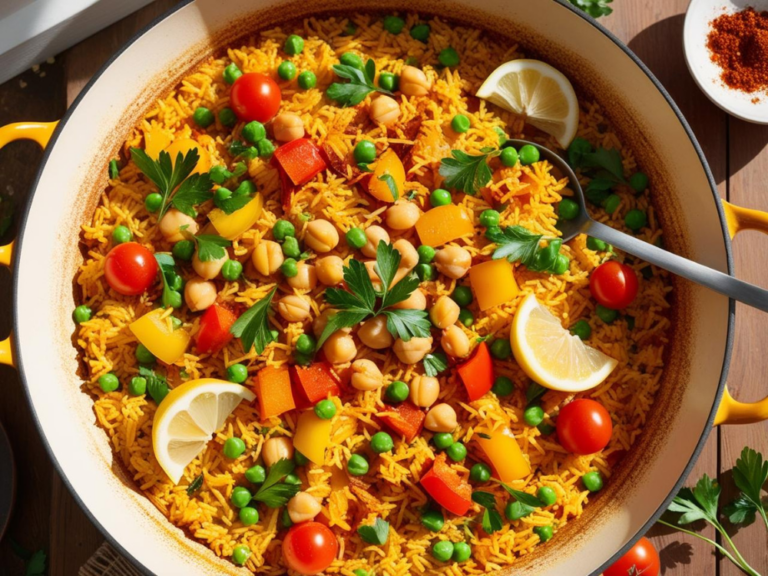
❌ Common Mistakes to Avoid When Making Chickpea Paella
Even though Spanish-Inspired Chickpea Paella is a one-pan wonder, a few missteps can make the difference between an okay dinner and a truly wow-worthy meal. The good news? These common mistakes are easy to avoid once you know what to look for 🙌
Here’s your personal cheat sheet to paella success — no burnt bottoms, bland bites, or soggy rice here!
1. 🔄 Stirring the Rice After Adding the Broth
This is the most common (and tempting) mistake. In most rice-based dishes, you’re encouraged to stir — but paella is different. Once the broth is added, do not stir again. This is how you achieve the famous socarrat — that golden, slightly crispy rice layer on the bottom of the pan. Stirring disrupts this magical texture and results in mushy rice. Resist the urge and trust the process!
2. 💧 Using Too Much Liquid
It might feel intuitive to drown the rice in broth to keep it from sticking, but too much liquid will result in a soupy or soggy texture — and we want fluffy, tender grains with a little bite. Stick to the recommended broth-to-rice ratio (around 2:1), and remember, it’s better to add more later than to fix an overly wet dish.
3. ⏱️ Rushing the Cook Time
Great paella takes time. Turning the heat up too high to speed things along may lead to burnt rice, undercooked veggies, or a lackluster flavor profile. Instead, let the dish simmer gently so the rice absorbs the broth and spices slowly, creating layers of flavor in every bite.
4. 🧂 Skimping on Spices
This dish gets its soul from bold Mediterranean flavors. Don’t be shy with the smoked paprika, turmeric, garlic, and saffron — they create the rich, deep flavor base that makes this recipe shine. Taste as you go, and adjust to your liking. Bland paella? Not on our watch! 💥
5. 🔥 Not Using a Wide, Shallow Pan
A large, shallow pan (like a paella pan or deep skillet) ensures the rice cooks evenly in a thin layer. If your pan is too deep or small, the rice can steam instead of simmer — leading to uneven cooking or mushy texture. Give your paella room to breathe so it can cook to golden perfection!
6. 🌾 Using the Wrong Rice
Not all rice is created equal! For paella, you want short-grain varieties like arborio, bomba, or calasparra. These absorb flavor beautifully while maintaining their shape. Long-grain rice like basmati or jasmine won’t give you the same creamy texture or classic paella feel.
7. ❌ Skipping the Lemon Finish
It might seem small, but the final squeeze of fresh lemon juice is essential. It brightens the dish, balances the savory spices, and ties all the flavors together. Skipping this step is like baking a cake and forgetting the frosting — still good, but missing that ✨magic✨ touch!
8. 🥫 Not Draining the Chickpeas Well
If you’re using canned chickpeas (which is totally fine!), make sure to drain and rinse them thoroughly. The liquid in the can (aquafaba) is great for other recipes, but in this case, it can water down your paella and affect the texture.
9. 🧊 Overloading with Frozen Ingredients
Frozen veggies like peas are a wonderful convenience, but adding too many frozen ingredients at once can lower the pan’s temperature and cause your rice to stop cooking properly. Add frozen peas near the end of cooking, when the heat is already consistent.
10. 😓 Lifting the Lid Too Often
Once you cover the paella to let it finish cooking, try not to peek too much. Every time you lift the lid, you release steam and reduce the heat needed to cook the rice evenly. Trust that it’s doing its thing — and enjoy that incredible smell wafting from the kitchen!
💡 Pro Tips to Guarantee Success:
Use low-sodium broth so you can better control the salt level
Let the paella rest for 5 minutes after cooking for the flavors to meld
If you’re unsure whether it’s done, taste a spoonful from the edge — the rice should be tender but not mushy
Always finish with fresh herbs and a little citrus to enhance flavor without extra salt
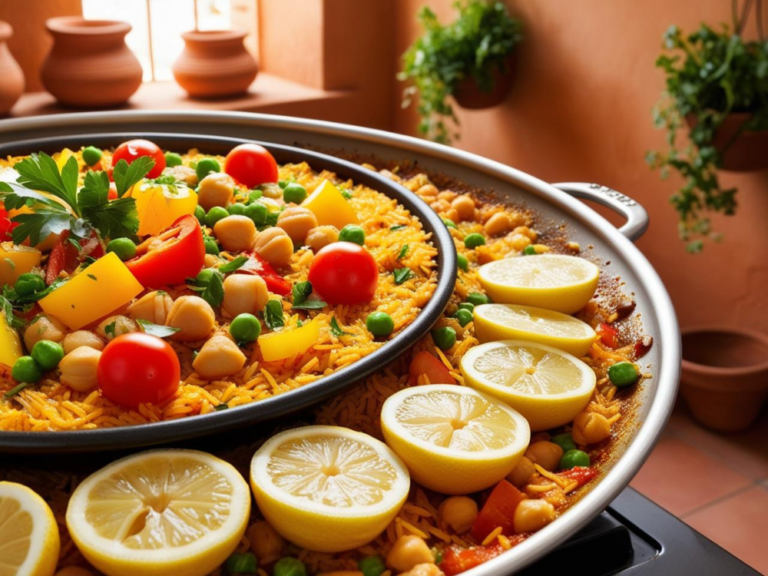
🍚 Can I Use a Different Type of Rice for Paella?
If you’ve been eyeing this recipe but only have a different type of rice in your pantry, you’re not alone — this is one of the most frequently asked questions when it comes to making paella at home. And the short answer is: yes, you can, but there are some important things to know before you make the swap!
💛 What Makes Paella Rice Unique?
Traditional paella uses short-grain rice — specifically Spanish varieties like bomba or calasparra. These grains are plump, starchy, and absorbent, which means they soak up all the delicious broth, spices, and flavor without turning to mush.
They’re also ideal for forming the socarrat — that crispy, caramelized bottom layer that’s the hallmark of a great paella. So while other rices can work, short-grain rice is the gold standard for texture and flavor.
🥄 Best Substitutes for Paella Rice (And How to Use Them)
Here’s a quick breakdown of the most common rice types and how they’ll behave in this recipe:
✅ Arborio Rice (Great Substitute)
This Italian short-grain rice is commonly used in risotto, and it’s one of the best stand-ins for bomba rice. It absorbs liquid beautifully and creates a slightly creamy texture, which works well in plant-based paella.
👉 Use a 2:1 liquid-to-rice ratio and avoid stirring after the broth goes in!
✅ Short-Grain Brown Rice (Healthier Alternative)
Looking to add more fiber and nutrients? Short-grain brown rice is a wholesome choice. Just be aware that it takes longer to cook (around 45–50 minutes) and needs more broth (closer to a 2.5:1 ratio).
👉 Pro Tip: Soak brown rice for 30 minutes beforehand to help it cook faster and more evenly.
⚠️ Jasmine or Basmati Rice (Use with Caution)
These long-grain varieties are aromatic and tasty — but they don’t absorb liquid the same way. They tend to stay firm or become mushy in a dish like paella because they’re not starchy enough to create the traditional texture.
👉 If you use them, reduce the broth slightly and expect a different final texture — more like a pilaf than traditional paella.
✅ Sushi Rice (Surprising But Solid)
Sushi rice is short-grain and sticky, which makes it a decent last-minute substitute. It’ll soak up flavors well, but it can be slightly gummier than bomba or arborio rice.
👉 Use the standard 2:1 liquid ratio and monitor closely to avoid overcooking.
✅ Cauliflower Rice (Low-Carb Option)
For a grain-free, low-carb twist, you can substitute the rice entirely with cauliflower rice. This will dramatically change the dish, but it’s great for paleo or keto diets.
👉 Reduce the broth to ½–1 cup total and cook for a much shorter time, just until tender.
🔥 Cooking Tips for Success (No Matter What Rice You Use)
Avoid stirring once the broth is added, even with substitutes — this helps develop better flavor and mimics the classic paella cooking technique.
Adjust the broth amount based on the rice type. Brown rice = more. Long-grain rice = slightly less.
Cover with a lid during the final 10–15 minutes to trap steam and help the rice finish cooking evenly.
Let it rest for 5–10 minutes off heat before serving — this allows the grains to finish absorbing moisture and develop flavor.
❓ Can I Mix Different Types of Rice?
Technically, yes — but be cautious. Mixing rice types with different cook times (like brown rice + white rice) can lead to uneven textures. If you’re going to mix, try to stay within the same grain category (e.g., arborio + sushi rice or brown + red rice).
💡 Final Word: Use What You Have, But Adjust as Needed
While traditional bomba rice makes for the most authentic paella experience, don’t stress if you don’t have it on hand. This recipe is designed to be flexible — so as long as you follow the cooking tips and watch your ratios, you can make a delicious, healthy paella with almost any rice you have 🧡
Remember: clean eating is about balance and flexibility — not perfection!
🍽️ What Can I Serve with Chickpea Paella? Perfect Pairings to Complete Your Meal
One of the best things about this Spanish-Inspired Chickpea Paella is that it’s a complete meal all on its own — packed with protein, fiber, veggies, and bold flavor. But if you’re serving guests, planning a dinner party, or just want to round out the experience with something extra, you might be wondering: What goes well with chickpea paella?
Whether you’re looking for refreshing sides, vibrant salads, or clean-eating desserts, here are some crave-worthy ideas to help you create a full, balanced, and totally satisfying Mediterranean-inspired spread
 Fresh & Flavorful Salads
Fresh & Flavorful Salads
A crisp, refreshing salad is the perfect contrast to the rich, savory flavors of paella. Choose something light and citrusy to balance the spices and saffron-infused rice:
 Spring Detox Salad with Lemon Vinaigrette
Spring Detox Salad with Lemon Vinaigrette
[Link to your recipe]
This salad is bursting with fresh greens, cucumber, radish, and a zesty lemon dressing that complements the earthiness of the paella beautifully. Plus, it’s packed with hydrating ingredients to keep things light and clean.
 Tomato & Cucumber Salad with Fresh Herbs
Tomato & Cucumber Salad with Fresh Herbs
Think Spanish countryside vibes — juicy tomatoes, crunchy cucumbers, red onion, parsley, and a splash of olive oil and sherry vinegar. Simple, rustic, and oh-so-good.
 Arugula + Citrus Salad
Arugula + Citrus Salad
Peppery arugula, juicy orange slices, and slivered almonds tossed with a light vinaigrette bring brightness and crunch to the plate.
 Clean Carbs & Simple Sides
Clean Carbs & Simple Sides
While the paella already contains rice, serving it with a small side or snack can elevate your meal for guests or larger gatherings:
 Garlic-Rubbed Toasted Sourdough or Baguette
Garlic-Rubbed Toasted Sourdough or Baguette
Perfect for scooping up that last bite of saffron rice! Look for whole grain or sourdough to keep things gut-friendly.
 Grilled Vegetables with Olive Oil & Lemon
Grilled Vegetables with Olive Oil & Lemon
Zucchini, eggplant, asparagus, and red onion lightly grilled and drizzled with lemon juice add smoky flavor and a colorful side dish.
 Stuffed Grape Leaves (Dolmas)
Stuffed Grape Leaves (Dolmas)
For a Mediterranean twist, serve a few dolmas on the side — they pair wonderfully with the rice and herbs in the paella.
 Dips, Spreads & Sauces
Dips, Spreads & Sauces
These additions are great if you’re serving paella family-style or as part of a tapas-style dinner:
 Clean-Eating Romesco Sauce
Clean-Eating Romesco Sauce
A Spanish staple made with roasted red peppers, almonds, garlic, olive oil, and smoked paprika. Spoon it on top of the paella for an extra hit of smoky depth.
 Lemon-Garlic Yogurt Dip
Lemon-Garlic Yogurt Dip
Perfect for dolloping on the side. Use coconut yogurt or cashew-based yogurt to keep it plant-based and creamy.
 Avocado Herb Aioli
Avocado Herb Aioli
Blend avocado with garlic, lemon, olive oil, and parsley for a silky, green, garlicky spread that contrasts beautifully with the paella spices.
 Drinks That Pair Beautifully
Drinks That Pair Beautifully
You don’t need to break out the sangria (unless you want to!) — here are some clean, refreshing drink options that enhance the experience:
 Sparkling Water with Citrus Slices
Sparkling Water with Citrus Slices
Infuse sparkling water with lemon, lime, or orange slices and fresh mint for a festive, healthy drink.
 Herbal Iced Tea (Mint or Hibiscus)
Herbal Iced Tea (Mint or Hibiscus)
Mint tea cools and balances, while hibiscus adds a tart, vibrant edge — both are caffeine-free and great for digestion.
 Citrus Mocktail Spritzers
Citrus Mocktail Spritzers
Combine fresh grapefruit or orange juice with sparkling water, ice, and a sprig of rosemary for a classy, alcohol-free beverage.
 Clean-Eating Desserts to End on a Sweet Note
Clean-Eating Desserts to End on a Sweet Note
Finish your meal on a light and energizing note with something naturally sweet and nourishing:
 Lemon Chia Seed Muffins
Lemon Chia Seed Muffins
[Link to your recipe]
These muffins are bright, zesty, and full of fiber and omega-3s. The citrus ties in beautifully with the lemony paella finish!
 Fresh Fruit with Coconut Whip
Fresh Fruit with Coconut Whip
A platter of berries, mango, and pineapple served with whipped coconut cream is simple, elegant, and naturally gluten-free.
 Roasted Pears with Cinnamon & Almonds
Roasted Pears with Cinnamon & Almonds
Baked pears drizzled with maple syrup and topped with toasted almonds — a warm, cozy way to end your paella night.
 Keep It Light, Fresh & Colorful
Keep It Light, Fresh & Colorful
When serving chickpea paella, think balance. The dish is warm, savory, and richly spiced — so pairing it with cool, crisp, and zesty sides is the way to go. And because this recipe is plant-based and clean-eating approved, you can mix and match any of these ideas without compromising your health goals or flavor cravings.
From simple salads to stunning citrusy mocktails, your paella dinner can easily become a beautiful, Mediterranean-inspired meal experience — perfect for sharing with family and friends, or just treating yourself to something extra special
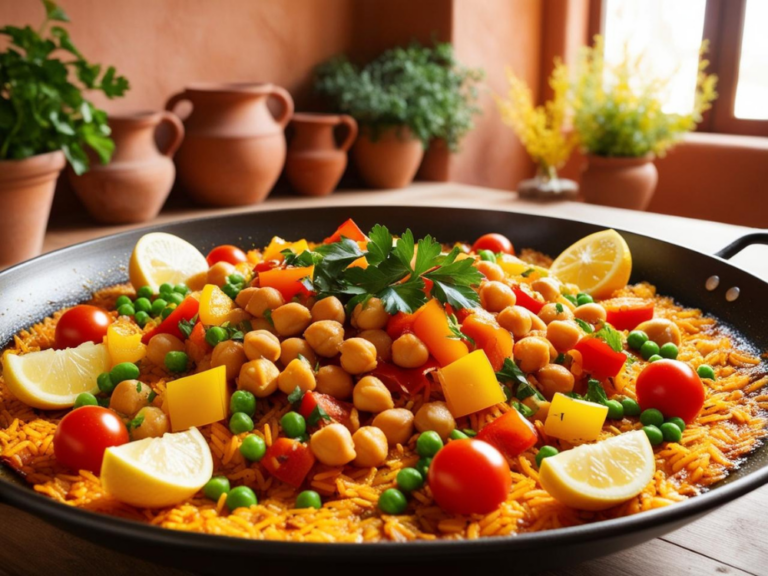
🥗 How Can I Make This Chickpea Paella for Meal Prep?
If you’re a fan of meal prepping — or just trying to simplify your week — you’re going to love how well this Spanish-Inspired Chickpea Paella fits into your clean-eating routine. It’s one of those magical meals that tastes just as amazing (if not better!) the next day, is incredibly easy to portion, and holds up beautifully in the fridge or freezer
Here’s everything you need to know to turn this one-pot wonder into multiple satisfying meals throughout the week:
 Why This Recipe is Perfect for Meal Prep
Why This Recipe is Perfect for Meal Prep
One-Pot Simplicity: Fewer dishes, faster cleanup
Hearty & Filling: The fiber-rich rice and chickpeas keep you satisfied for hours
Flexible Portions: Easily double or scale down the recipe to fit your needs
Reheats Like a Dream: Keeps its flavor and texture, no sogginess here!
Balanced Nutrition: Protein, fiber, healthy carbs, and veggies — all in one
 How to Portion for the Week
How to Portion for the Week
Once the paella has finished cooking and cooled for about 10–15 minutes, follow these easy steps to portion for the week:
Divide into individual containers — Aim for 4–6 portions, depending on your serving size goals.
Use glass meal prep containers with airtight lids for best freshness.
Add a lemon wedge or small container of fresh herbs (like parsley) on the side for brightening it up at mealtime.
Pro Tip: Want to keep things exciting? Add a different topping to each container — roasted red peppers, olives, avocado, or a dollop of romesco sauce!
 Can You Freeze Chickpea Paella?
Can You Freeze Chickpea Paella?
Yes — this dish freezes beautifully! Perfect if you’re prepping for the long haul.
 How to Freeze:
How to Freeze:
Let it cool completely
Portion into freezer-safe containers or reusable silicone bags
Label with the date and freeze for up to 1 month
 How to Reheat:
How to Reheat:
Thaw overnight in the fridge (or microwave from frozen in a pinch)
Reheat gently on the stovetop with a splash of veggie broth or water to revive the texture
Add fresh herbs or a squeeze of lemon before serving for that just-cooked flavor
 How Long Does It Last in the Fridge?
How Long Does It Last in the Fridge?
When stored properly in airtight containers, this chickpea paella will stay fresh in the refrigerator for 3 to 4 days. Just reheat and enjoy — no soggy leftovers here!
 Creative Ways to Repurpose Leftovers
Creative Ways to Repurpose Leftovers
Tired of the same bowl every day? Here are a few fun, creative ways to transform your chickpea paella throughout the week:
Stuff into wraps or pita pockets with greens and hummus
Serve over a bed of spinach or arugula for a warm rice salad
Pair with falafel or vegan sausage for a Mediterranean plate
Top with a fried or scrambled egg (if not vegan) for a hearty brunch
Use as a taco filling with avocado, lime, and hot sauce
 Make It Office or School Lunch-Ready
Make It Office or School Lunch-Ready
This paella travels well and reheats easily, making it ideal for lunchboxes and work meals:
Pack with a side salad and a lemon wedge for brightness
Use a divided container to keep any sauces or toppings separate until lunchtime
Pair with fruit or a clean-eating dessert, like lemon chia muffins or coconut date balls
 Save Time, Eat Better, Stress Less
Save Time, Eat Better, Stress Less
Meal prepping doesn’t have to be boring or repetitive — especially when you’ve got a flavorful, hearty dish like this chickpea paella ready to go. By cooking once and eating multiple times, you’ll save time, reduce decision fatigue, and stay on track with your clean eating goals all week long.
So go ahead — double the batch, fill up those containers, and get ready for delicious, nutrient-packed meals on repeat
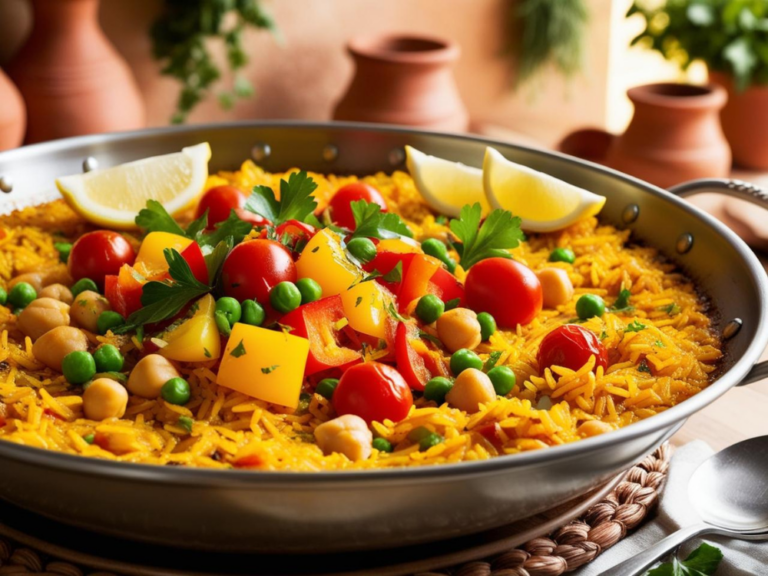
💪 Can I Add More Protein to This Vegan Paella?
Absolutely — and it’s one of the best ways to make this already-nourishing Spanish-Inspired Chickpea Paella even more satisfying, especially if you’re meal prepping, fueling your workouts, or cooking for growing kids and teens who need that extra boost
While chickpeas already offer a solid source of plant-based protein, there are tons of easy, clean ways to boost the protein content of this dish without compromising flavor, texture, or your clean-eating goals.
Here’s how to do it like a pro:
 Chickpeas: Your Protein-Packed Base
Chickpeas: Your Protein-Packed Base
First things first — chickpeas are no slouch when it comes to nutrition. One cup of cooked chickpeas provides about:
15 grams of plant-based protein
13 grams of fiber
A hearty dose of iron, zinc, and magnesium
So even without add-ins, this paella already offers a balanced, protein-rich base. But if you’re aiming for a higher protein intake, the following options can take it to the next level:
 Protein Add-Ins to Boost This Recipe
Protein Add-Ins to Boost This Recipe
These clean, vegan-friendly protein sources pair perfectly with the Spanish flavors of this paella:
 Tofu (Pan-Seared or Grilled)
Tofu (Pan-Seared or Grilled)
Tofu absorbs flavor beautifully and crisps up nicely. Cut extra-firm tofu into cubes, season with smoked paprika, garlic powder, and a splash of tamari, and pan-sear or air-fry until golden.
Protein per serving: ~10–15g
 Tempeh (Crumbled or Cubed)
Tempeh (Crumbled or Cubed)
Tempeh is fermented, gut-friendly, and has a firm, nutty texture. Marinate in olive oil, lemon juice, and spices, then grill or sauté. You can crumble it into the paella for a “meaty” texture.
Protein per serving: ~15g
 Vegan Sausage (Sliced or Crumbled)
Vegan Sausage (Sliced or Crumbled)
There are many clean-eating brands of plant-based sausage made with lentils, beans, and whole grains. Add slices or crumbles during the sauté stage for a protein-packed, smoky addition.
Protein per serving: ~13–20g depending on brand
 Lentils (Precooked or Canned)
Lentils (Precooked or Canned)
Lentils are an easy, affordable way to sneak in more protein and fiber. Stir in ½ to 1 cup of cooked brown or green lentils during the last 10 minutes of cooking.
Protein per ½ cup: ~9g
 Chopped Edamame or Green Peas
Chopped Edamame or Green Peas
Peas are already included in the recipe, but you can increase the quantity or sub in shelled edamame for even more protein power.
Protein per ½ cup edamame: ~9g
 Hemp Seeds (Sprinkled on Top)
Hemp Seeds (Sprinkled on Top)
These tiny seeds pack a punch of complete protein and healthy fats. Stir in or sprinkle on top just before serving.
Protein per 3 tbsp: ~10g
 Not Vegan? Here Are Optional Protein Boosters
Not Vegan? Here Are Optional Protein Boosters
If you’re not fully plant-based and looking for pescatarian or flexitarian options:
Grilled shrimp or scallops: A nod to traditional seafood paella
Soft-boiled or poached egg: Adds creaminess and protein
Grilled chicken strips: For high-protein omnivores (not part of clean vegan eating, but flexible for family meals)
 Balance Is Key: Don’t Overload the Pan
Balance Is Key: Don’t Overload the Pan
While it’s easy to get excited about boosting protein, it’s important not to overwhelm your pan or throw off the rice-to-liquid ratio. Aim to:
Add 1 to 1½ cups of extra protein for every full batch of paella
Keep additional protein on the top or sides instead of mixing into the rice too early
Avoid overloading with high-moisture proteins (like soft tofu or lentils) until the rice is nearly done
 Why Protein Matters in Plant-Based Meals
Why Protein Matters in Plant-Based Meals
Protein isn’t just about building muscle — it plays a key role in:
Stabilizing blood sugar
Supporting hormone balance
Maintaining energy levels
Helping you feel full and satisfied
In a carb-forward dish like paella, a little extra protein ensures you get the best of both worlds — comfort food vibes and sustainable energy
 Make It Yours!
Make It Yours!
Whether you’re prepping meals for the week, feeding a hungry family, or building your post-workout plate, boosting the protein in this plant-based paella is easy, customizable, and totally delicious. Choose your favorite add-ins, prep ahead, and enjoy this hearty dish as a satisfying, muscle-fueling, flavor-packed main course any day of the week
Spring Greens & Edamame Salad with Miso Dressing
Roasted Cauliflower and Chickpea Wraps
Spring Detox Salad with Lemon Vinaigrette
How Do I Make This Recipe More Authentic?
This Spanish-Inspired Chickpea Paella is a beautiful, clean-eating take on the classic — but if you’re a flavor explorer, food history buff, or just want to bring a little more old-world Spanish magic into your kitchen, you might be wondering how to make it feel even more authentic.
Traditional Spanish paella is all about technique, ingredients, and heart — it’s rustic, deeply flavorful, and built to bring people together. While we’ve already captured that spirit with vibrant veggies, saffron, and a one-pan method, here are several ways to take it closer to its roots while keeping it plant-based and healthy 🌿💃
🍚 Use Traditional Spanish Rice (Bomba or Calasparra)
One of the most defining aspects of authentic paella is the rice. Traditional paellas use bomba or calasparra rice — short-grain varieties grown in Spain that absorb liquid beautifully while maintaining structure.
✅ Why it matters: These rices soak up broth without becoming mushy, helping you get that perfect texture and the sought-after socarrat — the crispy golden rice crust at the bottom of the pan.
Can’t find bomba rice? Arborio (used in risotto) is a great alternative, but for ultimate authenticity, try sourcing bomba from a specialty store or online.
🌼 Always Include Saffron (and Bloom It Right!)
Saffron isn’t just about color — it’s about flavor and tradition. Authentic paella gets its unmistakable golden hue and floral aroma from this prized spice. To make the most of it:
Soak a small pinch of saffron threads in warm broth or water for 5–10 minutes before adding to the dish.
This helps the flavor bloom and ensures every grain of rice carries that earthy, luxurious taste.
💡 Budget-friendly tip: If real saffron is out of reach, you can mimic the color with turmeric, but nothing replaces saffron’s flavor in an authentic version.
🥘 Cook It in a Traditional Paella Pan
If you want the true paella experience, use a paellera — a wide, shallow, flat-bottomed pan designed to cook paella evenly over an open flame or wide burner.
✅ This helps develop that glorious socarrat — the caramelized, crispy bottom layer of rice that’s a signature element of authentic paella.
If you don’t have a paella pan, a large, flat skillet will still work — just avoid deep or narrow pans that crowd the rice.
🔥 Cook Over an Open Flame or Grill (Optional)
In Spain, paella is traditionally made outdoors over a wood fire, giving it a subtle smokiness and rustic flair. While this isn’t a must, it’s a fun way to add authentic vibes — especially for weekend gatherings or summer meals.
You can simulate this by cooking the paella on a grill or using smoked paprika to echo that fire-kissed flavor indoors.
Be sure to rotate the pan gently if needed to distribute heat evenly across the bottom.
🧄 Use Spanish-Style Sofrito as a Flavor Base
Sofrito is a slow-cooked mixture of onions, garlic, tomatoes, and olive oil that forms the aromatic backbone of many Spanish dishes, including paella.
To make your paella more authentic:
Sauté finely chopped onion and garlic until soft
Add fresh grated tomatoes (or canned if needed)
Let it simmer low and slow until thick and jammy before adding rice
This adds depth and umami — and sets the tone for the rest of the dish.
🧂 Keep It Rustic, Not Overloaded
Authentic paella is rustic and focused — not packed with too many ingredients. It’s all about balance, not excess.
Stick with just a few high-quality veggies and legumes (like bell peppers, tomatoes, peas, chickpeas), and avoid overloading with too many additions. Let each ingredient shine and give the rice space to do its thing.
🫒 Finish with Traditional Touches
Fresh parsley: Classic garnish in Spanish cooking
Lemon wedges: A must! They brighten and balance the richness
Olives or artichoke hearts: Mediterranean extras that are plant-based and traditional
No cheese, no dairy: Authentic Spanish paella is never creamy — save the cheese for another dish 😉
💃 Cultural Tip: Serve Family-Style
In Spain, paella is all about gathering around the table. It’s often served straight from the pan in the center of the table, encouraging everyone to dig in and enjoy communal, joyful eating.
To elevate your mealtime:
Bring the pan to the table with pride
Serve with small plates, lemon wedges, and a simple salad
Enjoy it slowly, with good conversation and laughter — that’s the real heart of paella
🧡 Final Thoughts: Tradition Meets Clean Eating
The beauty of this Spanish-Inspired Chickpea Paella is that it celebrates the soul of the original dish while honoring your clean-eating lifestyle. With a few intentional tweaks — like authentic rice, blooming saffron, and rustic techniques — you can experience a dish that feels both nutrient-rich and deeply rooted in tradition.
It’s not about being perfect — it’s about creating a meaningful connection to food, flavor, and culture in a way that fits your values ✨
🫗 How to Make This Chickpea Paella Oil-Free (No Flavor Sacrifices!)
Eating clean doesn’t mean sacrificing flavor — and this Spanish-Inspired Chickpea Paella is proof that you can create a deeply satisfying, flavor-rich dish without a single drop of oil. Whether you’re following a WFPB (Whole-Food, Plant-Based) lifestyle, looking to reduce processed fats, or cooking for someone with dietary restrictions, this easy oil-free version keeps all the bold Mediterranean magic with none of the grease
 Why Go Oil-Free?
Why Go Oil-Free?
Before we dive into the how-to, here’s a quick look at why many clean eaters are cutting back on oil:
Lower in calories: Oil is calorie-dense but nutrient-light
Better for heart health: Whole-food fats are gentler on arteries
Reduces inflammation: Many processed oils are pro-inflammatory
Whole-foods focus: WFPB diets prioritize nutrients, fiber, and natural flavor over extracted fats
The good news? You don’t need oil to build rich, layered flavor or get that crave-worthy satisfaction. Here’s how to pull it off — no flavor sacrifices, no sad food
 Step-by-Step: How to Make Chickpea Paella Oil-Free
Step-by-Step: How to Make Chickpea Paella Oil-Free
 1. Swap Olive Oil for Vegetable Broth or Water
1. Swap Olive Oil for Vegetable Broth or Water
Instead of starting the recipe with a sauté in olive oil, use low-sodium vegetable broth (or even just water!) to soften the aromatics. Begin with 2–3 tablespoons and add more as needed to prevent sticking.
Pro Tip: Use a nonstick or ceramic pan for best results when cooking without oil.
For extra flavor, choose a rich homemade veggie broth or one made with garlic, herbs, and bay leaf.
 2. Amp Up the Flavor with Bold Spices
2. Amp Up the Flavor with Bold Spices
Without oil as a base, spices take center stage — and that’s a good thing! Smoked paprika, turmeric, garlic, and saffron bring incredible warmth and depth.
Bloom your spices in the hot broth during the sautéing process to unlock their essential oils.
Add a pinch of cayenne or chili flakes for heat and dimension.
 3. Use Tomato as a Natural Richness Booster
3. Use Tomato as a Natural Richness Booster
Cooking down tomatoes until they’re thick and jammy creates a natural “umami bomb” and adds body to your dish.
Try using fresh grated tomatoes or a couple tablespoons of tomato paste for extra depth and richness — no oil needed.
 4. Add Acidity to Balance & Brighten
4. Add Acidity to Balance & Brighten
Lemon juice isn’t just a garnish — it plays a major role in enhancing flavor when you’re not using oil. It adds brightness, freshness, and balance to the savory elements of the paella.
Stir in a splash at the end of cooking and serve with extra wedges on the side.
You can also add a splash of vinegar (like sherry or apple cider vinegar) during cooking for even more complexity.
 5. Use Whole-Food Fats (Optional Add-In)
5. Use Whole-Food Fats (Optional Add-In)
If you’re oil-free but not fat-free, adding whole-food sources of healthy fat is a great way to maintain satiety and creaminess:
Avocado slices on top
Sprinkling of hemp seeds or ground flax
Tahini drizzle or cashew cream for richness
Chopped olives or marinated artichokes for Mediterranean flair
These options offer the richness of fat without using processed oils — and they bring additional nutrients like omega-3s, fiber, and plant-based protein!
 Extra Flavor Tips for Oil-Free Success
Extra Flavor Tips for Oil-Free Success
Caramelize onions low and slow in broth for sweetness and depth
Deglaze the pan with a splash of broth, lemon juice, or vinegar to lift up flavorful bits from the bottom
Add fresh herbs (like parsley or cilantro) at the end for vibrant, oil-free flavor
Use a smoky spice blend to mimic that savory, slightly charred note that oil often brings
 Oil-Free, Full Flavor
Oil-Free, Full Flavor
This oil-free version of chickpea paella proves that you don’t need processed fat to enjoy comfort food. By leaning into bold spices, veggie broth, citrus, and whole-food ingredients, you can keep your meals light, nourishing, and 100% delicious — all while supporting your clean-eating goals.
It’s comfort food with a conscience.
Spanish-Inspired Chickpea Paella
Equipment
- Large deep skillet or paella pan: To cook the paella evenly and help create the traditional socarrat (crispy bottom layer). A wide, shallow pan works best.
- Cutting board: For prepping all your veggies and herbs.
- Sharp knife: To chop onions, garlic, peppers, and tomatoes with precision.
- Garlic press (optional): Makes mincing garlic quick and easy.
- Measuring cups and spoons: For accurate measurement of rice, broth, spices, and lemon juice.
- Wooden spoon or spatula: To sauté vegetables and gently mix ingredients without damaging your pan.
- Lid for the pan: Essential for covering the paella during the final cooking phase to trap steam and help the rice finish cooking.
- Citrus juicer (optional): To squeeze fresh lemon juice easily and efficiently.
- Ladle or large serving spoon: For dishing out generous servings of your finished paella.
Ingredients
🌾 Base Ingredients:
- 2 tbsp olive oil
- 1 small yellow onion diced
- 4 garlic cloves minced
- 1 red bell pepper chopped
- 1 yellow bell pepper chopped
- 1 cup cherry tomatoes halved
- 1 ½ cups arborio or short-grain rice
- 1 tsp smoked paprika
- ½ tsp ground turmeric
- ¼ tsp cayenne pepper optional for heat
- Pinch of saffron threads or ½ tsp saffron powder
- Salt + black pepper to taste
- 3 cups low-sodium vegetable broth
- 1 15-oz can chickpeas, drained and rinsed
- 1 cup frozen peas
- 2 tbsp lemon juice
- Lemon wedges for serving
🌿 Optional Garnishes:
- Fresh parsley chopped
- Lemon zest
- Olives or artichoke hearts for extra Mediterranean flair!
Instructions
- Sauté your aromatics
- Heat olive oil in a large pan over medium heat. Add diced onion and sauté for 2–3 minutes until translucent. Stir in garlic and cook for another minute until fragrant.
- Build your flavor base
- Add the chopped bell peppers and halved cherry tomatoes. Cook for 5 minutes, stirring occasionally, until slightly softened. Sprinkle in smoked paprika, turmeric, cayenne (if using), salt, and pepper. Stir to coat everything in the spices.
- Toast the rice
- Add the rice and toast for 1–2 minutes, stirring to coat it in the oil and spices. This helps deepen the flavor and prevents mushiness later.
- Add broth + saffron
- Pour in the veggie broth and saffron. Give it a gentle stir, then spread everything evenly in the pan. DO NOT stir again after this step! Let it simmer uncovered for about 15 minutes.
- Add chickpeas + peas
- Gently spoon the chickpeas and peas over the rice without stirring. Cover the pan and reduce heat to low. Simmer for another 10–12 minutes until rice is tender and liquid is absorbed.
- Finish with lemon
- Drizzle lemon juice over the finished paella. Garnish with fresh parsley, lemon zest, and optional toppings like olives or artichokes.
- Serve & enjoy!
- Scoop generous portions onto plates and serve with lemon wedges. Best enjoyed warm and shared with people you love ❤️
Notes
🕒 Can I Make This Ahead?
Absolutely! This paella is ideal for prepping in advance. In fact, the flavors often deepen and improve after resting for a few hours or overnight. Here’s how to do it:- Same Day Prep: Make the paella in the morning, let it cool, and store it covered at room temperature for up to 2 hours before serving.
- Next Day Prep: Cook it fully, cool it completely, and refrigerate in an airtight container. Reheat just before serving with a splash of broth to revive moisture.
💡 Pro Tip: If you're serving guests, make the paella ahead and reheat it in the same pan for that “fresh off the stove” feel!
🧊 How to Store Leftovers
Refrigerate:Store cooled leftovers in an airtight container in the refrigerator for up to 4 days. Use glass containers to keep flavors intact and avoid staining from turmeric or tomato. Freeze:
Yes, this paella freezes beautifully! Spoon it into freezer-safe containers or reusable silicone bags, leaving room for expansion. Label with the date and freeze for up to 1 month.
🔥 How to Reheat Without Drying It Out
- Stovetop: Add a splash of vegetable broth or water to a nonstick pan. Heat gently over medium-low, stirring occasionally, until warmed through.
- Microwave: Place a serving in a microwave-safe dish, cover loosely with a damp paper towel, and microwave in 60-second intervals until hot.
- Oven (for large batches): Preheat to 350°F (175°C), place paella in an oven-safe dish, cover with foil, and heat for 15–20 minutes.
✨ Add a squeeze of lemon juice and fresh parsley after reheating to refresh the flavors!
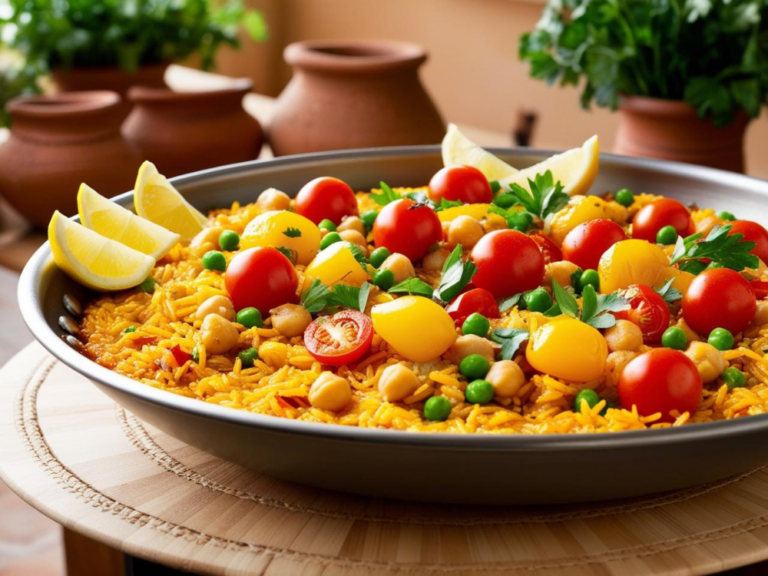
🧡 Bringing It All Together
This Spanish-Inspired Chickpea Paella is more than just a one-pot meal — it’s a celebration of vibrant flavors, nourishing ingredients, and the simple joy of cooking something beautiful from scratch. With its golden saffron rice, hearty chickpeas, and colorful veggies, this recipe captures the essence of Mediterranean comfort food while keeping it 100% clean and plant-based 🌿🥘
Whether you’re making it for a weeknight dinner, a cozy gathering, or your next meal prep rotation, this dish is here to remind you that healthy eating doesn’t have to be boring or complicated — it can be bold, exciting, and incredibly satisfying.
So gather your ingredients, turn up some music, and enjoy the process. Let the aroma fill your kitchen, and don’t forget to share it with someone you love — because food always tastes better when it’s shared 💛
Join Now!
If you enjoyed this Spanish-Inspired Chickpea Paella, don’t miss out on even more fresh, nourishing, and easy-to-make recipes like this! By joining our email community, you’ll get exclusive content, bonus recipes, and expert tips to help you make clean eating simple, flavorful, and fun.
✨ Enter your email & click below to subscribe—you’ll start receiving tasty inspiration right away! It only takes a minute to join our growing community of food lovers who are dedicated to making healthy meals both exciting and effortless!


 The Rise of Plant-Based Living
The Rise of Plant-Based Living According to recent studies, nearly 1 in 4 Americans are actively reducing their meat consumption — and dishes like this make it deliciously easy.
According to recent studies, nearly 1 in 4 Americans are actively reducing their meat consumption — and dishes like this make it deliciously easy. Comfort Food Without Compromise
Comfort Food Without Compromise Nutritional Benefits That Go Beyond the Plate
Nutritional Benefits That Go Beyond the Plate
 Sustainable & Eco-Friendly
Sustainable & Eco-Friendly Eat well, feel good, and do your part for the planet — all in one dish.
Eat well, feel good, and do your part for the planet — all in one dish. Incredibly Adaptable for Every Diet
Incredibly Adaptable for Every Diet Family-Friendly & Kid-Approved
Family-Friendly & Kid-Approved

 Instagrammable & Impressive
Instagrammable & Impressive A Cultural Classic with a Modern Twist
A Cultural Classic with a Modern Twist

 Saffron: The “Sunshine Spice” with Uplifting Properties
Saffron: The “Sunshine Spice” with Uplifting Properties Pro Tip: Curcumin is best absorbed with a bit of fat and black pepper, so the olive oil and spices in your paella help maximize turmeric’s bioavailability!
Pro Tip: Curcumin is best absorbed with a bit of fat and black pepper, so the olive oil and spices in your paella help maximize turmeric’s bioavailability! Why This Duo Works So Well Together
Why This Duo Works So Well Together

 Fresh & Flavorful Salads
Fresh & Flavorful Salads Spring Detox Salad with Lemon Vinaigrette
Spring Detox Salad with Lemon Vinaigrette Clean Carbs & Simple Sides
Clean Carbs & Simple Sides Dips, Spreads & Sauces
Dips, Spreads & Sauces Drinks That Pair Beautifully
Drinks That Pair Beautifully

 Why This Recipe is Perfect for Meal Prep
Why This Recipe is Perfect for Meal Prep How to Portion for the Week
How to Portion for the Week Can You Freeze Chickpea Paella?
Can You Freeze Chickpea Paella? How Long Does It Last in the Fridge?
How Long Does It Last in the Fridge? Stuff into wraps or pita pockets with greens and hummus
Stuff into wraps or pita pockets with greens and hummus Pair with falafel or vegan sausage for a Mediterranean plate
Pair with falafel or vegan sausage for a Mediterranean plate Top with a fried or scrambled egg (if not vegan) for a hearty brunch
Top with a fried or scrambled egg (if not vegan) for a hearty brunch Use as a taco filling with avocado, lime, and hot sauce
Use as a taco filling with avocado, lime, and hot sauce Make It Office or School Lunch-Ready
Make It Office or School Lunch-Ready
 Chickpeas: Your Protein-Packed Base
Chickpeas: Your Protein-Packed Base Protein Add-Ins to Boost This Recipe
Protein Add-Ins to Boost This Recipe Balance Is Key: Don’t Overload the Pan
Balance Is Key: Don’t Overload the Pan 1. Swap Olive Oil for Vegetable Broth or Water
1. Swap Olive Oil for Vegetable Broth or Water 2. Amp Up the Flavor with Bold Spices
2. Amp Up the Flavor with Bold Spices 3. Use Tomato as a Natural Richness Booster
3. Use Tomato as a Natural Richness Booster 5. Use Whole-Food Fats (Optional Add-In)
5. Use Whole-Food Fats (Optional Add-In)